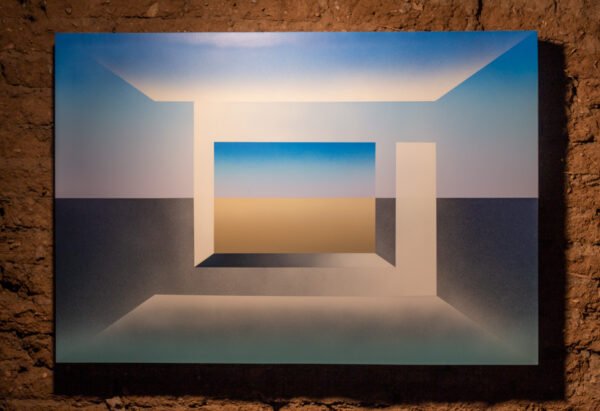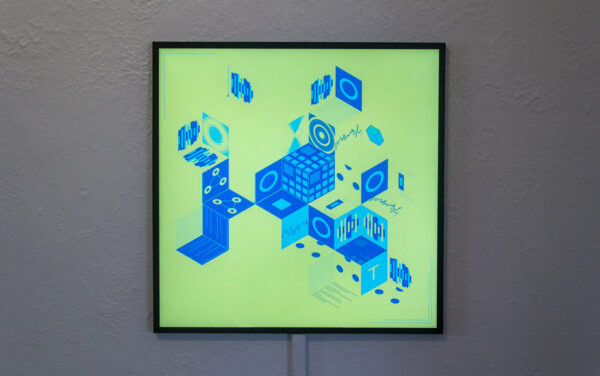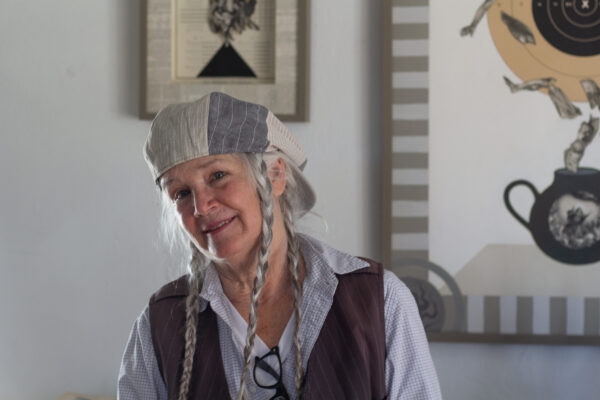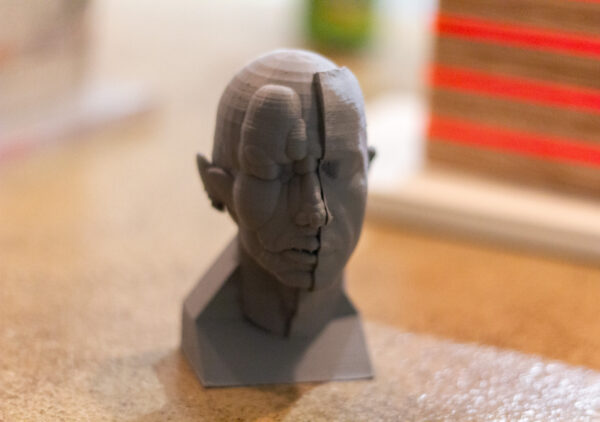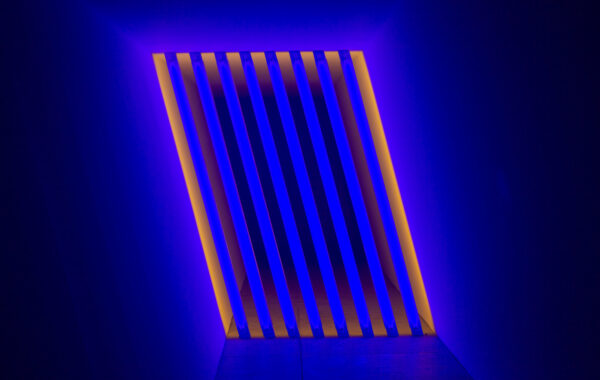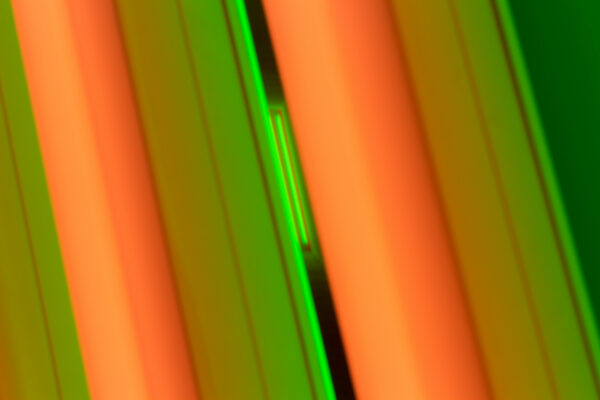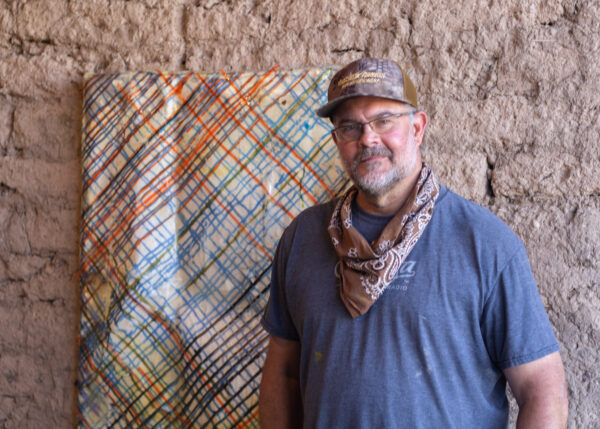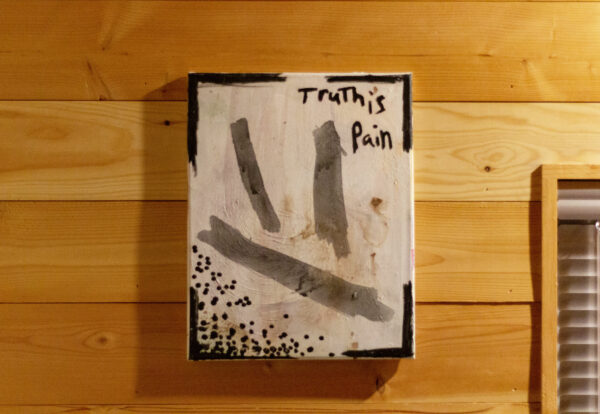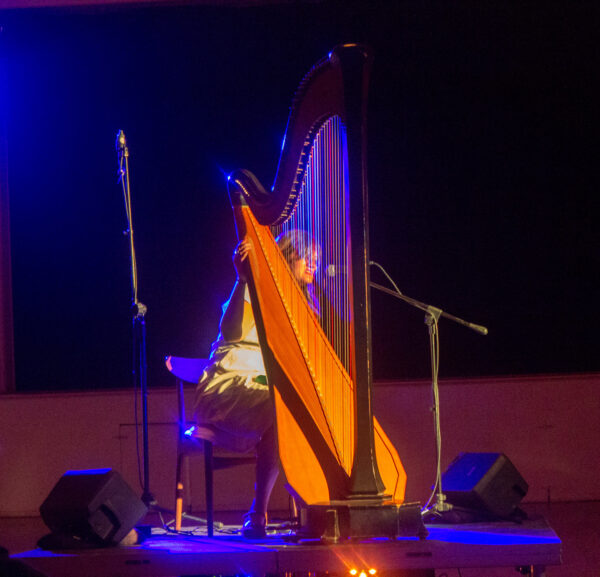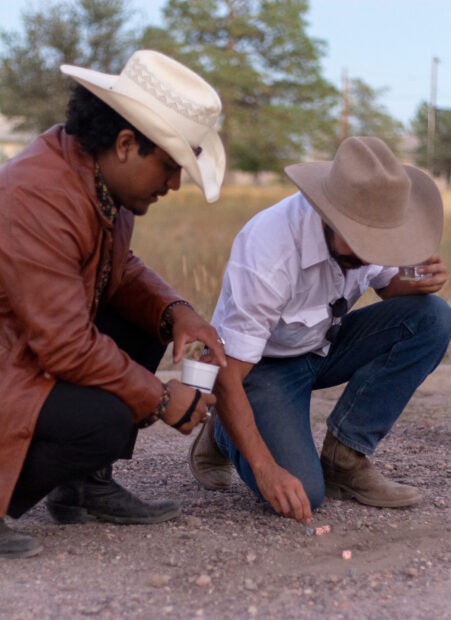I don’t know the last time I saw the Milky Way. Supposedly, it’s always there above our heads, but you can’t see the stars in Arlington, or Dallas, or Austin, where cars and the bright lights of buildings are as populous as people. When you get the opportunity to see the sky unfiltered, some celestial bodies are sharp, while others are so distant that they form the cloudy substance that gives our galaxy its name.
Maybe I last encountered the sky during a handful of childhood camping trips at Cleburne State Park, or during a rumspringa rager on the edge of town right before I left to study art in college. No matter the date, I can’t remember the last time I visualized, with my own eyes, the depths of the universe. Most likely, it would have been during the earliest part of my life, the part where I lived in the middle of nowhere, where nothing ever happened.
In far West Texas, among the yellow butterflies daring to cross the two-lane asphalt country roads and the eternally yawning landscape tufted with goat-head thistles, you might imagine that nothing ever happens. And then, you would be corrected by the darling interruption of Chinati Weekend in Marfa.
Texas cities, resplendent across the many climatic regions of the state, owe part of their general sensibilities to their environment (the tourist cities, as you can imagine, are especially forthcoming about this). Towns like Rockport have the gulf, which itself is teeming with life. Places like Marfa have air, sky, and more importantly, space.
The time between gas stations, the wait for service at peak hour (which happens also to be the only hour of service), and the cosmic bowl overhead constantly enunciate the spatial relationship of existence in the West Texas desert: smallness in a large container.
****
There are always newcomers to Marfa, and they tend to stand out because of the few spaces available to set up in town. Artblocks.io is new, though they argue that their platform for crypto art is rooted in the time-tested practice of generative art. Founded by native Houstonian Erick Calderon (known as @snowfro in the NFT community), Art Blocks is a platform for developing and selling generative artworks, much in the vein of the democratized nature that blockchain supporters endorse.
The platform’s flagship space on the main drag in Marfa is a desert domicile refitted to showcase pieces by users of the service, all in “mint zero,” which means that they’re effectively artist proofs of works. “Generative” here means that the works are produced via algorithmic derivation, and while some of the artists are exploring that definition, most of the pieces exist as wall works: as digital prints or looping videos.
Art Blocks’ party stretched across Chinati Weekend and assumed a relatively high competence surrounding the NFT space. Upon entering, I was asked if I was an artist or a collector, neither of which I am. Art Blocks guides gave short tours to guests, explaining the foundation of the NFT platform in conceptual art from the last half-century. Attendees donned name tags noting their discord handles, which were impossible to miss for the rest of the weekends’ events throughout town.
I overheard an artist from Panama saying they sold their car to pay the “gas fees” to mint their NFT, (a necessary evil when dealing works through a decentralized platform), and I couldn’t help but inquire further. In discussing expenses related to the technological medium, we quickly shifted to the issue of the public recognition of artworks that achieve obscene valuation in a short period time. (This isn’t necessary specific to NFT works, but the tendency of NFTs to meteorically rise in price has drawn artists to the medium nonetheless.)
The implications of creating in an environment designed to expedite the value of digital artifacts made me wonder why someone would choose to develop art on the platform in the first place. Twitter user @Modnarwolf offered some insight about why he participates in the NFT community: “my whole thing is a technological explorer, this is a new technology. I did virtual reality work before and that was super fascinating and fun to do. I just like exploring new technology.” About why he remains anonymous in the social media and NFT space, @Modnarwolf told me “@snowfro gets a ton of junk mail, random crappy art being spammed to his wallet. And then people will bother you all day and you’re beholden to them. Celebrity is a real problem because it happens so fast.”
Marfa is not a place where things happen quickly. Instead, it’s a place where a self-selected group of artists have chosen to take their time to slowly and methodically develop their work. At the edge of the Chinati Foundation, local artist Julie Speed hosted an open studio for duration of the weekend.
“Did you go to the NFT party?” Speed asked, after a brisk introduction. The previous day, someone from the Art Blocks crowd had come in and suggested that some of her works would make great NFTs. “Well they’re sorta the opposite,” she responded.
****
And then, there are those who are not new to Marfa.
At RULE Gallery, a Denver-based space that opened a Marfa outpost, Clark Richert’s exhibition Z-Space is on view. The show features a video that’s narrated by a robotic voice declaring that zones of three dimensional objects are articulated in space, and are defined by the shadows they cast on the wall.
Valerie Santerli waved me inside the front two rooms of RULE, which are always formal exhibitions. The rest of the house, in addition to being the gallerists’ living space, doubles as a back room showcasing works by the gallery’s artists.
At RULE I also met Fitz Lewis, who introduced himself by first name only, as everyone here does. Lewis recounted how the gallery has served as his home base in the past, grounding him before his graduate studies at the University of Kansas. He showed me a 3D print of a human bust, which was developed using anatomical analysis of the human face combined with modeling software.
Clark Richert is a mentor to Lewis; the two taught together from 2015-2018 at the Rocky Mountain College of Art & Design. RULE’s show of Richert’s work features historical drawings, which explore his evaluations of the periodic table. At 80, Richert is still producing new paintings — of his exploded cube paintings on the wall, colored with associations to the periodic elements, Lewis offers that the works are interpolating, saying “infinity as a confined number.”
****
The Chinati Foundation is housed in a decommissioned military fort made up of stuccoed buildings that vary in shape and size. Most of the site’s structures are horseshoe-shaped, with an exterior walkway and courtyard covered in wild grasses.
Some of the main buildings’ interiors are long barrels, which leave plenty of space for Dan Flavin’s permanent light installations in complementary colors. Six buildings contain Flavin’s 1996 piece, untitled (Marfa project). The installation’s lights create a middle barrier in the u-shaped buildings, which are accessible from entrances at either end. The center space is contained, inaccessible. Additionally, the lights are recessed into the central crevice of each building, meaning that you can walk into the trapezoidal drywall housing that hides them. There is a parallax effect that happens while viewing Flavin’s work here, as the long tubular bulbs are hung at congruent angles, drawing the viewer in like moth to flame.
Even for an open house weekend, Chinati was not particularly crowded. The visitors were as reverential as always, as to not disturb the work. Saturday’s main event featured a cast of improvisational musical performances, organized by David Dove of Nameless Sound, a Houston-based organization. The nine performers — including David Dove, Rolando Cantu, Laura Dykes, Carmina Escobar, Juan Garcia, John Alan Kennedy, Gabriel Martinez, Bhob Rainey, and Liz Tonne — played with stochastic, undefined control to fill the horseshoe-shaped chambers with percussive moments.
On my way down the line of Flavin’s identical structures, I passed Zoe Roden and Macaella Gray, who had just come from a momentary exchange between vocalists Liz Tonne and Carmina Escobar. They endorsed it as the best performance they had ever seen, and urged me to rush over to catch the duo’s performance.
Instead I happened upon John Alan Kennedy, who was walking the length of one of the Flavin galleries, slinking a bamboo wind chime and banging a water bottle on his head. An assortment of other water bottles lay next to some cymbals and a percussion instrument. The performers took 15-minute shifts, all performing simultaneously in different rooms of Flavin installation; it was not possible to see the entirety of the show — one had to be content with the reality of an exclusive experience.
Vocal performer Liz Tonne described the experience of building the performance after the group’s arrival on Tuesday. “The first thing we did was go into the spaces and hear what they sounded like. Dan Flavin had no interest in creating those spaces for sound. We didn’t know that either until we went there on Tuesday.” Flavin may not have architected the space for sound, but the musicians became enamored with the echoes that crossed the impassable center of his work.
****
“Old” places are really just the most enduring places in spite of circumstance. “New” is a convenient marker in contrast to anything that had existed for one second longer. It is possible that these attributes can exist in tandem and communicate with each other.
Z-Ranch, a curatorial outfit split between Los Angeles and Marfa, shows exhibitions in a structure that has long lost its roof. “This space is one of the oldest buildings in Marfa,” says operator Rob Brill. He moved into town in 2018, and made friends with the building’s owner when it changed hands in July of this year. There are no plans to demolish or update its mud brick walls that now show quarterly exhibitions of local artists.
The exhibition on view, Sacred and Profane, features paintings by Christina Moser Brill and Jean Goehring. Moser Brill renders her paintings in Illustrator before she executes them on canvas. “All of these paintings come from a feeling or a lucid dream kind of state that I’m trying to recreate in real life,” she told me. “I’ve been interested in incorporating sacred geometry.”
The underdrawing beneath the paintings speaks to her interest in existential wonder. In Montessori school, she wrote a religious paper on agnosticism. At the time, her mother was upset because she wanted Moser Brill to choose a “real” religion. The experience stuck with her, and she remains committed to the depiction of non-representational archetypes. “Most of my work is about the space between spaces. I’m interested in capturing that feeling of when you as a human are stuck in a middle space.”
Goehring’s works are industrial, perhaps a holdover from his origins in Houston. If Moser Brill is operating in the sacred, I wanted to know what Goehring’s side of the exhibition was. “I thought I would do a body of work and abandon it,” he responded.
His paintings are done on steel, which comes from his background working as a fabricator. To the steel has applied Epson ink, dried paint transfers, and his collection of Berol Eberhard Faber pens, which he calls “vintage stinky markers.” He said that he uses these because of the backlighting effect the ink has on the enameled steel. Its very obvious to see what he means: the translucent color the markers produce radiates on top of the steel’s white sheen. When I point out that this evening show, after sunset, required an overhead spot light to show the work, he replied, “they’re actually brighter during the day.”
Touring the show, Hockney’s recent declaration about abstraction seemed obvious to me. I asked Goehring how he felt about the end of the form, to which he said “I’d think we’re just getting started on abstraction, it’s wide open.”
****
At the dinner service for Saturday evening, hosted at Chinati’s Arena space, Hannah Lange, Zoe Roden, and Macaella Gray graciously offered to chauffeur me to a performance by Los Angeles-based harpist Mary Lattimore. The one catch is that we would have to stop by their apartment to collect some snacks and rehydrate, (which is always a prudent decision in the desert). While they gathered their belongings at home, I caught a glimpse of a painting by Gabriel Chavarria, another Marfa local and organizer of the Marfa Art Collective, which focuses on local and POC exhibitions and programming.
At dinner, Chavarria mentioned that the painting, which is part of a series produced in November of 2020, draws from his experience growing up in an alternative religious community. Seeing work in the homes of Marfans is an altogether different experience from viewing pieces in the galleries, institutions, and studios of this art city. The work was placed with no explanation or wall text; simply, it had meaning in its own right.
As we arrived a few minutes into Lattimore’s performance at Marfa’s historic USO Building/Visitor’s Center, the musician finished one piece and began another by offering an emotional anecdote: Lattimore recounted sending a recording of a new work to NASA, which was later beamed up to the International Space Station and played for the astronauts on board.
In the silent seconds between songs at the USO building, Zoe Roden suggested that the best way to experience Lattimore’s performance was to lay flat against the hardwood and feel the reverberation of the harp through one’s whole body. She was very much correct.
****
At some point, the weekend ended, and Marfa began to sleep. In the moments before we decided to rest, Chavarria and Nicolas Bustillos, of El Paso, introduce our group to a game of “threes,” in which six dice are rolled in succession, aiming for the lowest score possible. We gambled our precious one dollar bills, and were pitted against each other while always divvying up the winnings so that the game could keep going.
The experience of far West Texas is generally one of anticipation: waiting for the endless space to resolve into something that can be known or used; waiting for the restaurant to open or for the food to come to the table; waiting, like we do in the city, but not like we do in city. Until the last bar in town closed up shop, we asked the dice to give us favor in their twirling black eyes. The stars outnumbered our scores after every roll.


